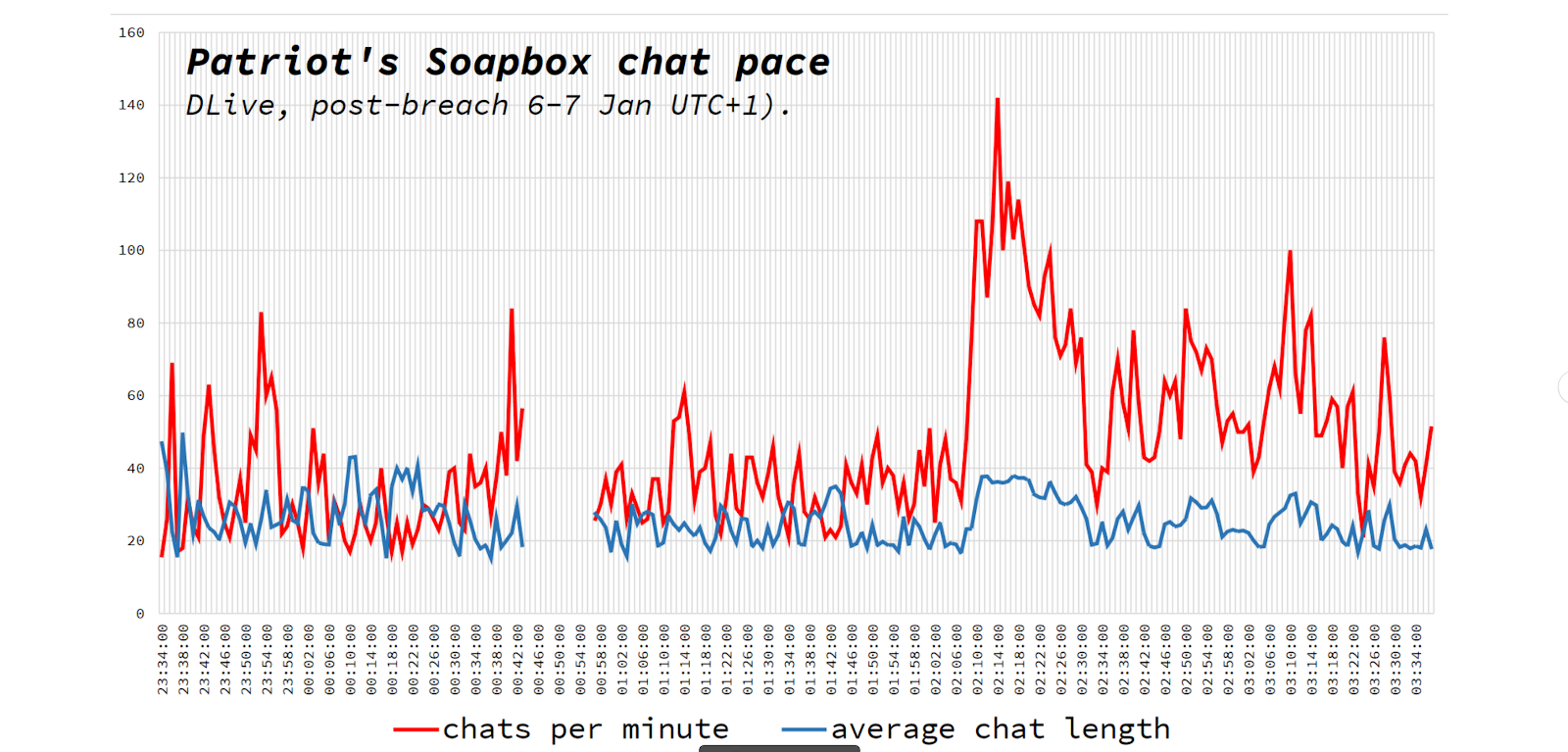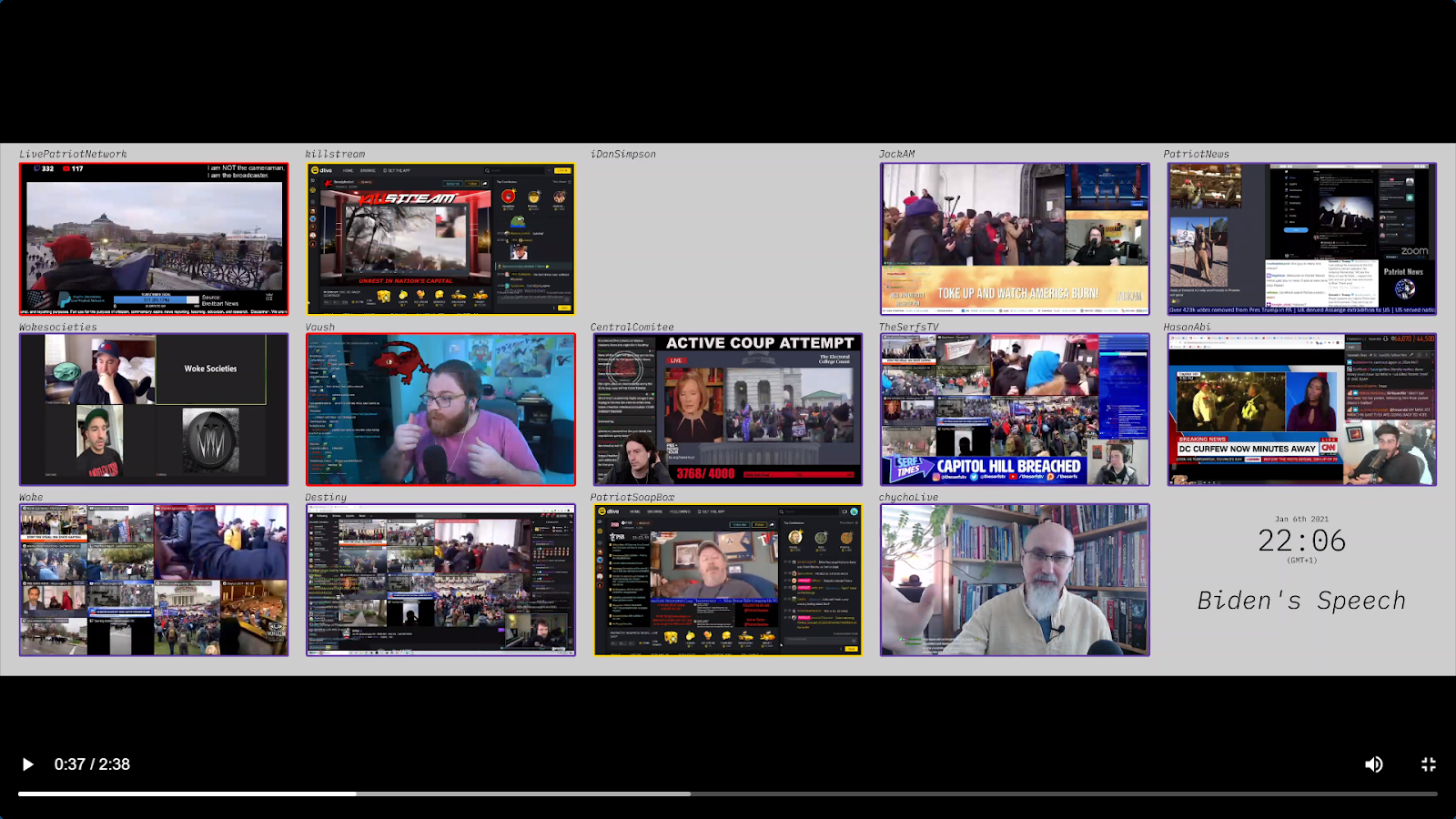A project by 
Streams of Conspiratorial Folklore
The objective of this project is to investigate online media as a stream of performances, rather than as archives of documents. We draw on the conceptual framework of "secondary orality" (Ong, 1982): the idea that, akin to preliterate folklore, the main concern of online subcultures is to secure the survival of ideas in a short-memory communication environment. Our fieldwork focussed on political and conspiratorial/anti-mainstream video streaming channels on Youtube, Twitch, and DLive, developing new methods, observation protocols and digital tools to explore the temporality of online communication.
In this page, we highlight two key aspects of conspiratorial streams
- Multi-flow composition
- Rhythm management
- and discuss the example of the streaming of the Capitol Hill Breach
Group members: Tommaso Venturini, Marc Tuters, Sal Hagen, Maria Castaldo, Daniel Bach, Axel Meunier, Marcantonio Bracale, Victor Loye, Christopher Murphy, Henrique da Costa, Pim van der Hulst, Jasper Knegt, Sara Nuta, Trevyn van Houwelingen, Thienthai Sangkhaphanthanon, Samuel Vitikainen, Maryam Tatari, Sarah Burkhardt, Niall Manley, Alessandra Facchin, Valentina Pagano, Matteo Bettini.
1. Multi-flow Composition
All the channels we observed are characterized by a composite communication architecture that arranges in one stream a multiplicity of elements. These elements can be distinguished according to their durability - stable/evanescent and visibility - visible/invisible.

|

|
|
Composition of Xanderhal’s Youtube stream
|
_Elements embedded in Xanderhal’s Youtube stream_ |
Read more here:
https://docs.google.com/document/d/1NomgNeO9F4ZKc7gvIyXT92CYHgpmsGM_oC07OqYwZD0/edit?usp=sharing See also an example of multi-flow multi-platform narration in the description of the streaming practice of
RedPill78:
Read the example here:
https://docs.google.com/document/d/1L2l_ZhcpIwzvnBr-d50K8lS8I61lRrcWY5pTMsYzw_U/edit?usp=sharing
In some cases, the composition of flows can produce complex effects of streamception where one stream is embedded in another.
 |
 |
|
Multi-stream coverage of the Capital Hill Breach by Woke
|
_Droste effect created by barryhendelson and Rogier Hop restreaming each other_ |
Read more here:
https://docs.google.com/document/d/10cI8N9cQCOEFXuXKwbhxGxZrSaQ4XHLRQvFHQIANKec/edit?usp=sharing
Most streams dedicate one or more frames to the conversations/reactions of the followers. Generally assured by a chat window, this function allows followers to add yet another flow to the stream through their posting of gifs and emotes.
 |
 |
 |
| Emotes employed in the chat of Killstream Dlive's channel |
Read more here:
https://docs.google.com/document/d/1k3zrow_w2idQx-IGdXSSzjDU0r9hG2XXhp1N4Hd8Bd4/edit?usp=sharing
2. Rhythm management
A second key element of online streams is the way they handle and synchronize the rhythmic variations of their different flows. These variations of rhythm enhance the real-time dramaturgy of the performance. Lasting for several hours, most streams are characterised by a base tempo that can be suddenly accelerated when important discussions or events take place. We found that a convenient way to observe these accelerations is observing the pace of the reaction in the chat. We developed three tool-prototypes to monitor the chat activity:
1. The Stream Modulator
The tool allows to view an archived stream, where the video speed is inverse to the chat speed. In other words, when few messages are posted, the stream is accelerated, when many messages are posted the stream is slowed down. In this way it automatically identifies parts of the stream when the chat gets more active.

See the tool in action here:
http://bit.ly/stream-mod
2. The Chat Seismograph
The tool allows to visualise the chat section of an archived stream along a timeline, so as to detect dramatic surges in the stream, but also to follow the variation of its content : the speed at which the vocabulary changes, providing a way to evaluate the evanescence or the permanence of particular moments/events in the stream.

|

|
 |
|
This first tool tracks the speed of the chat window using two metrics: the number of messages posted per minute and their average length (number of characters).
See the his-res mock-up here: link1 link2 link3
|
The main panel of the second tool displays all chat messages, separating all-caps texts (blue) from all other texts (black). Left panel provides an overview of the whole chat, highlighting where the discussion rhythm increased.
See the his-res mock-up here: link1 link2
|
The third tool computes and shows the textual similarity between the messages posted in the chat in subsequence intervals of 10 minutes. See the his-res mock-up here: link |
An interesting (and somewhat extreme) example of change of rhythm is a technical issue experienced by the Patriot Soap Box Dlive channel prior to the Capitol Hill breach. In the few minutes the video flow was down, the chat went into a paranoid phase in which the users started to frantically discuss the possibility of the channel having been de-platformed.
Read more here:
https://docs.google.com/document/d/1OjsJj4YABZtnhwsa93d_QKXx3WWtRYLI_Ajn2ZIuW1A/edit
3. The Streams Synchroniser

By extracting screenshots from multiple channels at regular intervals and by arranging them in a common timeline, the Streams Synchroniser produces a static or dynamic collage of streams and allows identifying moments in which different channels sync on the same narratives or cover the same events.
See the tool in action here:
http://bit.ly/stream-sync
3. Streaming the Capitol Raid

The Capitol Raid of January 6 2021 presented a unique chance to showcase the tools we developed. As both the #StopTheSteal demonstration and the certification of the U.S. 2020 Presidential Election were widely streamed by the streamers that we had observed during the winter school, the sudden appearance of a new kind of live political event was thus present in our data.
Stream Synchroniser
We worked from from a list of five key moments of the Capitol Raid: (1) the Senate stopping its proceedings; (2) Trump’s deleted tweets condemning Mike Pence; (3) the Huffington Post reporter tweeting images of rioters; (4) Biden’s Speech; and (5) the reaction to the now deleted Trump's video-tweet asking his supporters to go home.


See the:
https://youtu.be/JU9dQLLa8JI
The many screens of our synchronized streams offer an overview of the streaming landscape and reveal spikes of interest by a diverse group of streamers from across the political spectrum and different platforms. The tool allows to catch a glimpse of the different modes of streaming, coverage priorities and perspectives of the streamers. It also shows how “internet-browsing” streams synthesise the coverage from different sources (e.g. Twitter, news channels, other streams)
Read a more here:
https://docs.google.com/document/d/1jR6YisXPwIlnNUG1WsB1rAXfSXK_9lWT2MAYexAbJjU/edit?usp=sharing
Chat Seismograph


|
We used the second tool of the Chat Seismograph to investigate the chat rhythm of Hasan Abi's stream.
A peculiar chat rhythm emerges around the 2:23, pinpointing an interesting moment in the stream. This is the moment when the streamer and the chat realizes that protesters have made their way into the capitol building and disrupted the Senate's debate.
See the his-res image here: link |

|
Looking at the chat speed of rightwing conspiracy channel “The Patriots Soapbox” we can see moments were the chat speeds up.
The spike in the image corresponds to the moment in which the US Congress resumes its sessions, and the streamers start criticising Pence and McConnel, riling up the chat with a higher chat-speed.
The tool allows pinpointing interesting moments, either because of quicker chat activity or because more nuanced conversations are taking place with longer chat messages.
|

 Copyright © by the contributing authors. All material on this collaboration platform is the property of the contributing authors.
Copyright © by the contributing authors. All material on this collaboration platform is the property of the contributing authors. 

